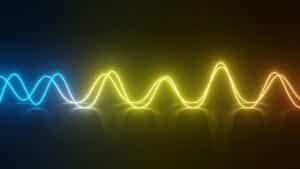Deep theta meditation music uses specific frequencies to help achieve deep relaxation and enhance your meditation. Discover top tracks to enrich your practice and improve mental clarity.
Understanding Deep Theta Meditation

Deep theta meditation is a technique that involves entering a level of consciousness where the brain emits low-frequency theta waves. These particular waves facilitate relaxation and amplify creative thinking, paving the way for an extraordinary meditative journey. Delving into deep theta meditation can unlock powerful states of creativity and healing, providing advantages that extend well beyond those found in standard meditation routines.
Partaking in this form of deep meditation brings forth enhanced mental lucidity and emotional equilibrium. It serves to reduce stress and anxiety levels significantly while fostering an overall sense of emotional wellness. The state attained through deep theta meditation resembles an intermediary phase nestled between wakefulness and sleep, delivering restorative effects with far-reaching implications for both mental vigor and physical vitality.
Imagine yourself gently adrift within a tranquil sphere devoid of daily pressures or strife—a realm you enter through deep theta mediation which allows exploration into expansive realms of mental imagery and creativity—thus standing as a formidable instrument aimed at self-enhancement alongside profound relaxation. In this blog post, we’ll explore how you might effectively utilize the potentialities offered by the frequency known as “theta” for deeper meditative practices.
The Science Behind Theta Waves
Theta waves, which oscillate between 4 and 7, oscillate between 4 and 7. Hz, are tied to states of profound relaxation, meditation, and subconscious exploration. By tuning into the theta range, your mind is primed for engaging in reverie-like thoughts, processing emotions deeply and reflecting inwardly. The healing properties attributed to this frequency spectrum play a significant role in fostering both physical recuperation and psychological renewal.
The enhancement of neuroplasticity through theta wave stimulation aids in sharpening mental capabilities as well as building emotional strength. This positions theta-focused meditation practices as beneficial for individuals recovering from taxing periods or health challenges by reinforcing their cognitive function and resilience while also strengthening intuitive abilities—connecting users more profoundly with their internal wisdom during meditative experiences.
Incorporating binaural beats that fall within the theta frequency domain serves to amplify creative thinking while deepening levels of meditation practice. These specific beats usually apply frequencies ranging from 4-8 Hz. Hz designed to align brainwave activity towards an intensified state of calmness alongside elevated contemplative depths. Delving into music crafted for theta meditation demonstrates how these soundwaves aid in unlocking creativity, tapping into intuition, facilitating healing processes, and ensuring thoroughgoing tranquility.
Benefits of Deep Theta Meditation Music

Music designed for theta meditation significantly improves your meditative practices, offering increased capacity for visualization and tapping into profound mental imagery. This is especially advantageous for individuals engaging in guided meditation or creative visualization methods. Theta music fosters greater mental lucidity by enhancing concentration and cognitive abilities.
Such music aids in achieving a state of deep relaxation that can diminish stress and anxiety levels. Its soothing influence has holistic effects – not only relaxing the mind but also contributing to lower blood pressure and healthier heart functionality. Diverse tracks are crafted to achieve specific goals like alleviating stress, emotional recuperation, or augmenting cognitive faculties.
To retain focus during meditation sessions, instrumental tunes without lyrical content are recommended since words may cause distractions. Music with slower rhythms—ranging from 60 to 80 beats per minute—is conducive to relaxation as it encourages stable breathing patterns. Simplicity in musical composition plays a pivotal role in sustaining attention and serenity throughout one’s practice.
Incorporating sound therapy techniques such as binaural beats within mediation can lead to improved mood states and heightened psychomotor performance. Adding natural sounds into your playlist Elevates feelings of peace while fostering an affinity with nature’s surroundings during meditation times.
How to Use Theta Meditation Music Effectively
Employing top-notch headphones enhances the experience of theta meditation music by delivering binaural beats directly and precisely to each ear, optimizing their impact. Experimentation with various types of theta music will assist in discovering what most effectively complements your meditative process.
For those new to this form of meditation, it’s advisable to begin with shorter sessions while becoming familiarized with theta music and then gradually extend these periods as comfort increases. Adding established techniques like focusing on one’s breathing or using mental imagery can intensify the effects of theta meditation. Establishing a regular practice ensures that meditation becomes seamlessly integrated into your everyday routine.
Leveraging binaural beats has been known to trigger brainwaves associated with the theta state, which is beneficial for augmenting creativity, improving mood, and enhancing memory recall. To achieve optimal deep meditation and relaxation conditions, combine these auditory stimuli within an environment that is tranquil and cozy.
Top Theta Meditation Tracks

It is essential to carefully pick the right theta meditation music for achieving a profound state of deep meditation. An exemplary choice would be “Now… The Technology” by M. C. Cannon, which has been recognized for its ability to facilitate deeper meditative states more effectively compared to standard meditation sounds. When selecting such tracks, opt for ones that feature a steady beat and smooth transitions in order to sustain a tranquil ambiance.
Theta range music can significantly elevate your experience during meditation by diminishing stress and cultivating an inner sense of peace. These tracks often blend harmonious tunes with elements of nature’s acoustics, crafting an enveloping audio landscape conducive to relaxation. Certain esteemed theta mediation albums are designed specifically with the intent to foster vivid dreaming and stimulate creative thinking while engaged in meditative practices.
For optimal efficacy, confirm that your chosen tracks are tuned into the correct theta frequency spectrum and utilize premium headphones when listening. These steps will help ensure you obtain maximum benefits from your transformative journey through guided soundscapes during meditation sessions.
Spotlight on “Requiem” by Mozart
Wolfgang Amadeus Mozart’s “Requiem,” held in high regard as one of the most distinguished works for meditation, was brought to life by the renowned National Philharmonic Orchestra of Great Britain. This acclaimed masterpiece, crafted by Mozart in 1791, stands at the pinnacle of requiems and its recording took place within London’s iconic Abbey Road Studios with this prestigious orchestra.
With a start defined by the enthralling voices of the National Philharmonic Chorus accompanied by a majestic 9ft Steinway Concert Grand Piano, “Requiem” offers an immersive sound experience. Its orchestral richness and contemplative themes are specially tailored to foster deep reflection and facilitate a state conducive to meditative practices.
Immersing oneself in Mozart’s “Requiem” can greatly enhance meditation sessions through stimulation of creativity and intuition. The intricate blend of robust orchestral tones alongside theta frequencies produces an unmatched auditory backdrop that acts as a potent medium for meditation.

Creating Your Theta Meditation Playlist
Crafting a well-rounded theta meditation playlist is crucial for sustaining an unbroken state of deep meditation. Your selection should consist of tracks that seamlessly blend into one another, providing a uniform and captivating meditative journey. Choose pieces ranging from five to ten minutes in duration to promote thorough engagement without becoming restless.
Assemble your playlist with an assortment of theta meditation music tailored to various purposes such as alleviating stress, facilitating emotional healing, or enhancing creativity. A harmoniously arranged playlist can lead you towards deeper and more effective meditation sessions.
By meticulously picking out and structuring your album’s track list, you forge a potent instrument for profound mediation and tranquility. Immerse yourself in the vibrations that resonate personally with you by delving into this curated compilation designed for effective contemplative practice.
Enhancing Your Meditation Experience

Creating a serene and inviting atmosphere is crucial for improving your meditation experience. To attain deeper levels of meditation, it’s important to select an area that has been tailored with appropriate lighting and designed to reduce noise disturbances.
By using binaural beat therapy, which delivers varying sound frequencies to each ear, resulting in the brain perceiving a unified tone, you can assist in lessening anxiety and amplifying the effects of meditation. Adding these beats into your routine may increase both the depth and effectiveness of your meditation sessions.
The solemn themes found within “Requiem” could provide an avenue for intense self-reflection when meditating. The combination of carefully chosen music and a tranquil setting can significantly boost well-being by fostering a more profound state of relaxation during practice.
To maximize benefits from meditation, integrate harmonious music choices into an established comfortable spot free from interruptions. These practices are key contributors to promoting relaxation, healing processes, and refining the quality of your meditation techniques.
Summary
In summary, deep theta meditation music offers a powerful way to achieve relaxation, mental clarity, and emotional balance. By understanding the science behind theta waves and the benefits of using theta meditation music, you can enhance your meditation practice and overall well-being.
We encourage you to explore different tracks, including Mozart’s “Requiem,” and create a personalized playlist that resonates with you. By following the tips provided, you can create a serene environment and achieve a deeper, more transformative meditation experience.
Frequently Asked Questions
Who composed the Requiem that the meditation music is based on?
The Requiem that the meditation music is based on was composed by Wolfgang Amadeus Mozart.
What type of piano was used to play the Requiem?
The Requiem was performed on a 9-foot Steinway Concert Grand Piano.
Where was the Requiem recorded?
The Requiem was recorded at Abbey Road Studios in London, a renowned location known for its rich musical history.
What frequencies does the meditation use to enhance creativity and intuition?
The meditation employs theta frequencies between 4 Hz and 7 Hz. Hz to effectively boost creativity and intuition.
How can binaural beats enhance the meditation experience?
Binaural beats enhance the meditation experience by inducing theta brainwaves, which can improve creativity, mood, and memory retention.
This auditory stimulus facilitates deeper relaxation and focus during meditation.



